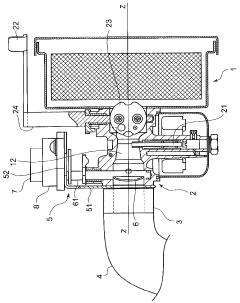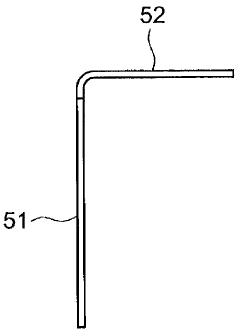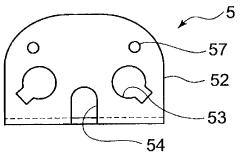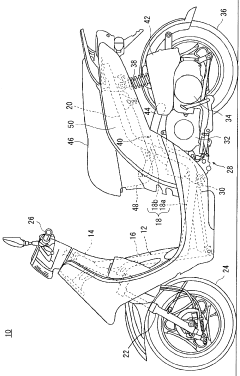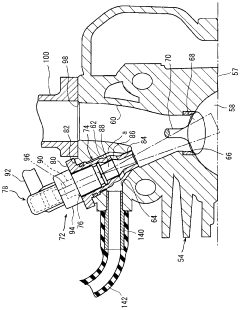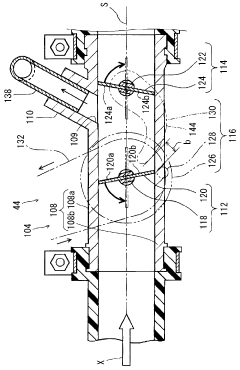How Throttle Body Design Affects Freight Train Efficiency
JUL 18, 202510 MIN READ
Generate Your Research Report Instantly with AI Agent
Patsnap Eureka helps you evaluate technical feasibility & market potential.
Throttle Body Evolution in Freight Locomotives
The evolution of throttle body design in freight locomotives has been a crucial factor in improving the efficiency and performance of freight trains over the years. Initially, throttle bodies in early steam locomotives were simple valves that controlled the flow of steam to the cylinders. As diesel-electric locomotives became prevalent, the throttle body design evolved to regulate fuel and air mixture in diesel engines.
In the 1950s and 1960s, mechanical throttle bodies were the standard, utilizing a butterfly valve controlled by a mechanical linkage. These designs, while functional, had limitations in terms of precise control and responsiveness. The 1970s saw the introduction of electronic throttle control systems, which marked a significant leap forward in throttle body technology for freight locomotives.
The 1980s brought about the development of more sophisticated electronic fuel injection systems, which required more advanced throttle body designs. These new throttle bodies incorporated sensors to measure airflow and temperature, allowing for more accurate fuel metering and improved engine efficiency. This period also saw the introduction of multi-point fuel injection systems in some locomotive models, further enhancing fuel economy and power output.
During the 1990s, throttle body designs began to focus on reducing emissions and improving fuel efficiency. Variable geometry throttle bodies were introduced, allowing for better airflow management across different engine speeds and loads. This innovation significantly improved locomotive performance, especially during acceleration and at low speeds.
The turn of the millennium brought about the integration of computer-controlled throttle bodies in freight locomotives. These systems utilized advanced algorithms to optimize fuel-air mixture based on various parameters such as engine load, speed, and environmental conditions. This level of precision control led to substantial improvements in fuel efficiency and reduced emissions.
In recent years, the focus has shifted towards intelligent throttle body systems that incorporate machine learning and predictive analytics. These cutting-edge designs can anticipate changes in train load and track conditions, adjusting the throttle response in real-time for optimal efficiency. Additionally, the use of lightweight materials and advanced manufacturing techniques has resulted in more durable and responsive throttle bodies.
The latest developments in throttle body design for freight locomotives include the integration of hybrid and electric propulsion systems. These designs must accommodate the unique requirements of dual-mode operations, seamlessly transitioning between diesel and electric power sources. Furthermore, regenerative braking systems have been incorporated into modern throttle body designs, allowing for energy recovery and improved overall efficiency of freight trains.
In the 1950s and 1960s, mechanical throttle bodies were the standard, utilizing a butterfly valve controlled by a mechanical linkage. These designs, while functional, had limitations in terms of precise control and responsiveness. The 1970s saw the introduction of electronic throttle control systems, which marked a significant leap forward in throttle body technology for freight locomotives.
The 1980s brought about the development of more sophisticated electronic fuel injection systems, which required more advanced throttle body designs. These new throttle bodies incorporated sensors to measure airflow and temperature, allowing for more accurate fuel metering and improved engine efficiency. This period also saw the introduction of multi-point fuel injection systems in some locomotive models, further enhancing fuel economy and power output.
During the 1990s, throttle body designs began to focus on reducing emissions and improving fuel efficiency. Variable geometry throttle bodies were introduced, allowing for better airflow management across different engine speeds and loads. This innovation significantly improved locomotive performance, especially during acceleration and at low speeds.
The turn of the millennium brought about the integration of computer-controlled throttle bodies in freight locomotives. These systems utilized advanced algorithms to optimize fuel-air mixture based on various parameters such as engine load, speed, and environmental conditions. This level of precision control led to substantial improvements in fuel efficiency and reduced emissions.
In recent years, the focus has shifted towards intelligent throttle body systems that incorporate machine learning and predictive analytics. These cutting-edge designs can anticipate changes in train load and track conditions, adjusting the throttle response in real-time for optimal efficiency. Additionally, the use of lightweight materials and advanced manufacturing techniques has resulted in more durable and responsive throttle bodies.
The latest developments in throttle body design for freight locomotives include the integration of hybrid and electric propulsion systems. These designs must accommodate the unique requirements of dual-mode operations, seamlessly transitioning between diesel and electric power sources. Furthermore, regenerative braking systems have been incorporated into modern throttle body designs, allowing for energy recovery and improved overall efficiency of freight trains.
Market Demand for Efficient Freight Transport
The global freight transport industry is experiencing a significant shift towards more efficient and sustainable solutions, driven by increasing environmental concerns, rising fuel costs, and the need for improved operational efficiency. This market demand for efficient freight transport has placed a spotlight on innovative technologies that can enhance the performance of freight trains, with a particular focus on throttle body design improvements.
The freight rail sector, a crucial component of the global logistics network, is under pressure to reduce its carbon footprint while simultaneously improving its operational efficiency. This dual challenge has created a substantial market opportunity for technologies that can optimize fuel consumption and increase the overall efficiency of freight trains. Industry analysts project that the global rail freight transport market will continue to grow, with a compound annual growth rate (CAGR) of 3.4% from 2021 to 2026, reaching a value of $290 billion by the end of the forecast period.
One of the key drivers of this market demand is the increasing emphasis on reducing greenhouse gas emissions in the transportation sector. Governments worldwide are implementing stricter regulations and setting ambitious targets for carbon reduction, compelling freight operators to seek more fuel-efficient solutions. This regulatory landscape has created a strong incentive for the development and adoption of advanced throttle body designs that can significantly improve the fuel efficiency of freight trains.
Moreover, the volatility of fuel prices has heightened the importance of fuel efficiency in the freight transport industry. With fuel costs representing a substantial portion of operational expenses for rail freight companies, there is a growing demand for technologies that can minimize fuel consumption without compromising performance. This economic imperative has led to increased investment in research and development focused on optimizing throttle body design and other engine components.
The market is also witnessing a trend towards the integration of smart technologies in freight transport systems. There is a growing demand for throttle body designs that incorporate advanced sensors and control systems, enabling real-time optimization of engine performance based on various operational parameters. This trend aligns with the broader industry movement towards digitalization and the Internet of Things (IoT) in logistics and transportation.
Furthermore, the competitive landscape of the freight transport industry is driving the demand for efficiency improvements. Rail operators are constantly seeking ways to gain a competitive edge by reducing operational costs and improving service reliability. Advanced throttle body designs that can deliver measurable improvements in fuel efficiency and engine performance are highly sought after in this competitive environment.
In conclusion, the market demand for efficient freight transport solutions, particularly those focusing on throttle body design improvements for freight trains, is robust and growing. This demand is underpinned by environmental regulations, economic pressures, technological advancements, and competitive forces within the industry. As the freight transport sector continues to evolve, the development of innovative throttle body designs that can significantly enhance train efficiency is likely to remain a key area of focus and investment.
The freight rail sector, a crucial component of the global logistics network, is under pressure to reduce its carbon footprint while simultaneously improving its operational efficiency. This dual challenge has created a substantial market opportunity for technologies that can optimize fuel consumption and increase the overall efficiency of freight trains. Industry analysts project that the global rail freight transport market will continue to grow, with a compound annual growth rate (CAGR) of 3.4% from 2021 to 2026, reaching a value of $290 billion by the end of the forecast period.
One of the key drivers of this market demand is the increasing emphasis on reducing greenhouse gas emissions in the transportation sector. Governments worldwide are implementing stricter regulations and setting ambitious targets for carbon reduction, compelling freight operators to seek more fuel-efficient solutions. This regulatory landscape has created a strong incentive for the development and adoption of advanced throttle body designs that can significantly improve the fuel efficiency of freight trains.
Moreover, the volatility of fuel prices has heightened the importance of fuel efficiency in the freight transport industry. With fuel costs representing a substantial portion of operational expenses for rail freight companies, there is a growing demand for technologies that can minimize fuel consumption without compromising performance. This economic imperative has led to increased investment in research and development focused on optimizing throttle body design and other engine components.
The market is also witnessing a trend towards the integration of smart technologies in freight transport systems. There is a growing demand for throttle body designs that incorporate advanced sensors and control systems, enabling real-time optimization of engine performance based on various operational parameters. This trend aligns with the broader industry movement towards digitalization and the Internet of Things (IoT) in logistics and transportation.
Furthermore, the competitive landscape of the freight transport industry is driving the demand for efficiency improvements. Rail operators are constantly seeking ways to gain a competitive edge by reducing operational costs and improving service reliability. Advanced throttle body designs that can deliver measurable improvements in fuel efficiency and engine performance are highly sought after in this competitive environment.
In conclusion, the market demand for efficient freight transport solutions, particularly those focusing on throttle body design improvements for freight trains, is robust and growing. This demand is underpinned by environmental regulations, economic pressures, technological advancements, and competitive forces within the industry. As the freight transport sector continues to evolve, the development of innovative throttle body designs that can significantly enhance train efficiency is likely to remain a key area of focus and investment.
Current Throttle Body Challenges in Freight Trains
The current throttle body design in freight trains faces several significant challenges that impact overall efficiency and performance. One of the primary issues is the difficulty in achieving precise control over fuel delivery across a wide range of operating conditions. Freight trains operate in diverse environments, from flat terrains to steep inclines, and must maintain optimal fuel efficiency throughout these varying conditions. The existing throttle body designs often struggle to provide the necessary adaptability, leading to suboptimal fuel consumption and reduced engine efficiency.
Another challenge lies in the durability and reliability of throttle body components. Freight trains operate for extended periods under harsh conditions, subjecting the throttle body to extreme temperatures, vibrations, and contaminants. This environment can lead to premature wear and tear of critical components, resulting in decreased performance and increased maintenance requirements. The need for more robust materials and designs that can withstand these demanding conditions while maintaining consistent performance is a significant hurdle for current throttle body technology.
The integration of electronic control systems with mechanical throttle body components presents another set of challenges. While electronic throttle control offers the potential for more precise fuel management, it also introduces complexity and potential points of failure. Ensuring seamless communication between electronic sensors, control units, and mechanical actuators is crucial for maintaining optimal engine performance. However, achieving this level of integration while maintaining the ruggedness required for freight train operations remains a significant technical challenge.
Size and weight constraints also pose difficulties in throttle body design for freight trains. The need for compact yet high-performance components that can handle the massive airflow requirements of large diesel engines is a constant challenge for engineers. Balancing the need for adequate airflow capacity with space and weight limitations often requires compromises that can impact overall engine efficiency.
Furthermore, the throttle body's role in emissions control adds another layer of complexity to its design. As environmental regulations become increasingly stringent, throttle bodies must not only manage fuel delivery for optimal performance but also contribute to reducing harmful emissions. This dual requirement often leads to design trade-offs that can impact engine responsiveness and efficiency.
Lastly, the cost-effectiveness of advanced throttle body designs remains a significant challenge. While more sophisticated designs could potentially offer improved performance and efficiency, the high costs associated with research, development, and implementation often hinder widespread adoption in the freight train industry. Striking a balance between performance improvements and economic viability is a persistent challenge in throttle body innovation for freight trains.
Another challenge lies in the durability and reliability of throttle body components. Freight trains operate for extended periods under harsh conditions, subjecting the throttle body to extreme temperatures, vibrations, and contaminants. This environment can lead to premature wear and tear of critical components, resulting in decreased performance and increased maintenance requirements. The need for more robust materials and designs that can withstand these demanding conditions while maintaining consistent performance is a significant hurdle for current throttle body technology.
The integration of electronic control systems with mechanical throttle body components presents another set of challenges. While electronic throttle control offers the potential for more precise fuel management, it also introduces complexity and potential points of failure. Ensuring seamless communication between electronic sensors, control units, and mechanical actuators is crucial for maintaining optimal engine performance. However, achieving this level of integration while maintaining the ruggedness required for freight train operations remains a significant technical challenge.
Size and weight constraints also pose difficulties in throttle body design for freight trains. The need for compact yet high-performance components that can handle the massive airflow requirements of large diesel engines is a constant challenge for engineers. Balancing the need for adequate airflow capacity with space and weight limitations often requires compromises that can impact overall engine efficiency.
Furthermore, the throttle body's role in emissions control adds another layer of complexity to its design. As environmental regulations become increasingly stringent, throttle bodies must not only manage fuel delivery for optimal performance but also contribute to reducing harmful emissions. This dual requirement often leads to design trade-offs that can impact engine responsiveness and efficiency.
Lastly, the cost-effectiveness of advanced throttle body designs remains a significant challenge. While more sophisticated designs could potentially offer improved performance and efficiency, the high costs associated with research, development, and implementation often hinder widespread adoption in the freight train industry. Striking a balance between performance improvements and economic viability is a persistent challenge in throttle body innovation for freight trains.
Existing Throttle Body Optimization Techniques
01 Improved throttle body design
Enhanced throttle body designs focus on optimizing airflow and reducing turbulence. This includes modifications to the shape, size, and internal components of the throttle body to improve overall efficiency and engine performance.- Improved throttle body design: Enhanced throttle body designs focus on optimizing airflow and reducing turbulence. This includes modifications to the shape, size, and internal components of the throttle body to improve overall efficiency and engine performance.
- Electronic throttle control systems: Implementation of electronic throttle control systems allows for more precise regulation of airflow into the engine. These systems use sensors and actuators to adjust throttle position based on various engine parameters, resulting in improved efficiency and responsiveness.
- Throttle body cleaning and maintenance: Regular cleaning and maintenance of the throttle body can significantly improve its efficiency. This includes removing carbon deposits, adjusting idle speed, and ensuring proper sealing to maintain optimal airflow and prevent performance issues.
- Integration of additional components: Incorporating additional components into the throttle body design can enhance its efficiency. This may include integrating idle air control valves, air temperature sensors, or fuel injection systems directly into the throttle body assembly for improved overall performance.
- Material selection and manufacturing techniques: Utilizing advanced materials and manufacturing techniques can improve throttle body efficiency. This includes the use of lightweight alloys, precision machining, and advanced coating technologies to reduce friction, improve durability, and enhance overall performance.
02 Electronic throttle control systems
Implementation of electronic throttle control systems allows for more precise management of airflow into the engine. These systems use sensors and actuators to adjust throttle position based on various engine parameters, resulting in improved efficiency and responsiveness.Expand Specific Solutions03 Throttle body cleaning and maintenance
Regular cleaning and maintenance of the throttle body can significantly improve its efficiency. This includes removing carbon deposits, adjusting idle speed, and ensuring proper sealing to maintain optimal airflow and prevent performance issues.Expand Specific Solutions04 Integration of additional components
Incorporating additional components into the throttle body design, such as air filters, sensors, or fuel injection systems, can enhance overall efficiency. These integrated designs can improve airflow management, fuel delivery, and engine performance monitoring.Expand Specific Solutions05 Material selection and manufacturing techniques
Utilizing advanced materials and manufacturing techniques in throttle body production can lead to improved efficiency. This includes the use of lightweight materials, precision machining, and innovative coating technologies to reduce friction and enhance durability.Expand Specific Solutions
Key Players in Locomotive Throttle Body Manufacturing
The throttle body design's impact on freight train efficiency is currently in a growth phase, with increasing market size due to the global focus on sustainable transportation. The technology's maturity varies among key players, with established companies like CRRC Qingdao Sifang, Mitsubishi Heavy Industries, and Siemens Mobility leading in innovation. Emerging players such as CRRC Tangshan and China State Railway Group are rapidly advancing their capabilities. The competitive landscape is characterized by a mix of traditional rail manufacturers and technology-focused firms, each striving to optimize throttle body design for improved fuel efficiency, reduced emissions, and enhanced overall train performance.
Siemens Corp.
Technical Solution: Siemens Corp. has developed a high-performance throttle body system for freight trains that incorporates advanced materials and precision engineering. Their design utilizes a lightweight composite construction that reduces overall weight while maintaining durability. The throttle body features a variable-geometry intake system that optimizes airflow across different engine speeds and load conditions. Siemens has also integrated their proprietary digital twin technology, which allows for real-time monitoring and predictive maintenance of the throttle body[4]. The system includes advanced sensors and actuators that enable precise control of air-fuel mixture, resulting in improved combustion efficiency and reduced fuel consumption. Additionally, Siemens has implemented a regenerative braking system that works in conjunction with the throttle body to recover energy during deceleration, further enhancing overall train efficiency[5].
Strengths: Lightweight design, advanced digital monitoring, and energy recovery capabilities. Weaknesses: Potentially higher maintenance requirements due to complex electronic systems.
China State Railway Group Co., Ltd.
Technical Solution: China State Railway Group Co., Ltd. has developed an advanced throttle body design for freight trains that incorporates electronic control and variable geometry technology. This system utilizes precise fuel metering and air intake control to optimize combustion efficiency across different operating conditions. The design features a multi-port injection system that allows for more accurate fuel distribution, resulting in improved fuel economy and reduced emissions. Additionally, the company has implemented a smart throttle control algorithm that adapts to various load conditions and track gradients, ensuring optimal power delivery and energy efficiency[1][3]. The throttle body is also equipped with integrated sensors for real-time monitoring of air flow, temperature, and pressure, enabling dynamic adjustments to maintain peak performance[2].
Strengths: Improved fuel efficiency, reduced emissions, and adaptive performance across various operating conditions. Weaknesses: Higher initial cost and increased complexity compared to traditional mechanical throttle systems.
Innovative Throttle Body Design Patents
Air intake device for engine
PatentWO2011043132A1
Innovation
- A common throttle body design is achieved by using an L-shaped bracket with an actuator mounting system that integrates with the air cleaner, carburetor, and heat insulators, allowing for the attachment of an electronic governor actuator without modifying the carburetor, and includes features like thermal insulation and stud bolts for improved durability and assembly.
Throttle body and powered two-wheeled vehicle provided therewith
PatentWO2010113981A1
Innovation
- A throttle body design featuring butterfly-type first and second throttle valves with a tubular portion, through hole, and branch pipe to improve intake air flow between the valves, ensuring efficient air introduction into an auxiliary passage, which enhances fuel atomization and efficiency.
Environmental Impact of Throttle Body Efficiency
The environmental impact of throttle body efficiency in freight trains is a critical consideration in the ongoing efforts to reduce the carbon footprint of the transportation sector. Efficient throttle body design can significantly contribute to lower fuel consumption and reduced emissions, making it an essential factor in improving the overall environmental performance of freight rail systems.
One of the primary environmental benefits of optimized throttle body efficiency is the reduction in fuel consumption. By allowing for more precise control of air intake and fuel mixture, an efficient throttle body design enables the engine to operate at optimal levels across various speed and load conditions. This results in less fuel being burned unnecessarily, leading to a decrease in overall fuel consumption. Consequently, this reduction in fuel usage directly translates to lower carbon dioxide emissions, a major contributor to global warming and climate change.
Moreover, improved throttle body efficiency can lead to a reduction in other harmful emissions, such as nitrogen oxides (NOx) and particulate matter. These pollutants are known to have detrimental effects on air quality and human health, particularly in urban areas where freight trains frequently operate. By optimizing the air-fuel mixture and combustion process, efficient throttle body designs can help minimize the production of these harmful byproducts.
The environmental benefits extend beyond direct emissions reductions. Enhanced throttle body efficiency can also contribute to decreased wear and tear on engine components, potentially extending the lifespan of locomotives. This, in turn, reduces the environmental impact associated with the manufacturing and disposal of replacement parts and entire locomotives.
Furthermore, improved efficiency can lead to increased payload capacity per train, potentially reducing the number of trips required to transport the same amount of freight. This optimization of freight movement can result in an overall reduction in the environmental footprint of the transportation network, including decreased land use for rail infrastructure and reduced noise pollution in areas surrounding rail lines.
It is worth noting that the environmental impact of throttle body efficiency improvements can be further amplified when combined with other technological advancements in freight train design. For instance, integrating efficient throttle bodies with regenerative braking systems and aerodynamic improvements can create a synergistic effect, leading to even greater reductions in fuel consumption and emissions.
In conclusion, the environmental impact of throttle body efficiency in freight trains is substantial and multifaceted. From reduced greenhouse gas emissions to improved air quality and resource conservation, optimizing throttle body design plays a crucial role in enhancing the sustainability of freight rail transportation. As the industry continues to prioritize environmental stewardship, further advancements in throttle body technology will likely remain a key focus area for reducing the ecological footprint of freight train operations.
One of the primary environmental benefits of optimized throttle body efficiency is the reduction in fuel consumption. By allowing for more precise control of air intake and fuel mixture, an efficient throttle body design enables the engine to operate at optimal levels across various speed and load conditions. This results in less fuel being burned unnecessarily, leading to a decrease in overall fuel consumption. Consequently, this reduction in fuel usage directly translates to lower carbon dioxide emissions, a major contributor to global warming and climate change.
Moreover, improved throttle body efficiency can lead to a reduction in other harmful emissions, such as nitrogen oxides (NOx) and particulate matter. These pollutants are known to have detrimental effects on air quality and human health, particularly in urban areas where freight trains frequently operate. By optimizing the air-fuel mixture and combustion process, efficient throttle body designs can help minimize the production of these harmful byproducts.
The environmental benefits extend beyond direct emissions reductions. Enhanced throttle body efficiency can also contribute to decreased wear and tear on engine components, potentially extending the lifespan of locomotives. This, in turn, reduces the environmental impact associated with the manufacturing and disposal of replacement parts and entire locomotives.
Furthermore, improved efficiency can lead to increased payload capacity per train, potentially reducing the number of trips required to transport the same amount of freight. This optimization of freight movement can result in an overall reduction in the environmental footprint of the transportation network, including decreased land use for rail infrastructure and reduced noise pollution in areas surrounding rail lines.
It is worth noting that the environmental impact of throttle body efficiency improvements can be further amplified when combined with other technological advancements in freight train design. For instance, integrating efficient throttle bodies with regenerative braking systems and aerodynamic improvements can create a synergistic effect, leading to even greater reductions in fuel consumption and emissions.
In conclusion, the environmental impact of throttle body efficiency in freight trains is substantial and multifaceted. From reduced greenhouse gas emissions to improved air quality and resource conservation, optimizing throttle body design plays a crucial role in enhancing the sustainability of freight rail transportation. As the industry continues to prioritize environmental stewardship, further advancements in throttle body technology will likely remain a key focus area for reducing the ecological footprint of freight train operations.
Regulatory Framework for Locomotive Components
The regulatory framework governing locomotive components plays a crucial role in ensuring the safety, reliability, and efficiency of freight train operations. In the context of throttle body design and its impact on freight train efficiency, several key regulations and standards come into play.
The Federal Railroad Administration (FRA) in the United States is the primary regulatory body overseeing locomotive components. The FRA's regulations, codified in Title 49 of the Code of Federal Regulations (CFR), set forth comprehensive requirements for locomotive design, maintenance, and operation. Specifically, 49 CFR Part 229 addresses locomotive safety standards, including provisions related to throttle control systems.
International standards also influence the regulatory landscape for locomotive components. The International Union of Railways (UIC) provides guidelines and specifications that are widely adopted across different countries. These standards often serve as a basis for national regulations and industry best practices.
Environmental regulations have a significant impact on throttle body design and overall locomotive efficiency. The Environmental Protection Agency (EPA) in the United States has established stringent emissions standards for locomotives under 40 CFR Part 1033. These regulations drive the development of more efficient throttle body designs that can help reduce fuel consumption and emissions.
Safety certification processes are an integral part of the regulatory framework. Organizations such as the Association of American Railroads (AAR) provide industry standards and certification programs for locomotive components, including throttle control systems. Compliance with these standards is often mandatory for operating on major rail networks.
The regulatory landscape also encompasses performance standards that directly influence throttle body design. These standards typically specify requirements for throttle response time, precision of control, and reliability under various operating conditions. Such specifications ensure that throttle bodies contribute to overall locomotive efficiency while maintaining safe operation.
Maintenance and inspection regulations form another critical aspect of the framework. Regular inspections and maintenance procedures for throttle bodies and related components are mandated to ensure ongoing compliance with safety and performance standards. These requirements often dictate the design features of throttle bodies to facilitate ease of maintenance and inspection.
As technology advances, regulatory bodies are adapting their frameworks to accommodate innovations in throttle body design. This includes provisions for electronic throttle control systems and integration with advanced train management systems. Such regulatory adaptations aim to foster innovation while maintaining rigorous safety and efficiency standards.
The Federal Railroad Administration (FRA) in the United States is the primary regulatory body overseeing locomotive components. The FRA's regulations, codified in Title 49 of the Code of Federal Regulations (CFR), set forth comprehensive requirements for locomotive design, maintenance, and operation. Specifically, 49 CFR Part 229 addresses locomotive safety standards, including provisions related to throttle control systems.
International standards also influence the regulatory landscape for locomotive components. The International Union of Railways (UIC) provides guidelines and specifications that are widely adopted across different countries. These standards often serve as a basis for national regulations and industry best practices.
Environmental regulations have a significant impact on throttle body design and overall locomotive efficiency. The Environmental Protection Agency (EPA) in the United States has established stringent emissions standards for locomotives under 40 CFR Part 1033. These regulations drive the development of more efficient throttle body designs that can help reduce fuel consumption and emissions.
Safety certification processes are an integral part of the regulatory framework. Organizations such as the Association of American Railroads (AAR) provide industry standards and certification programs for locomotive components, including throttle control systems. Compliance with these standards is often mandatory for operating on major rail networks.
The regulatory landscape also encompasses performance standards that directly influence throttle body design. These standards typically specify requirements for throttle response time, precision of control, and reliability under various operating conditions. Such specifications ensure that throttle bodies contribute to overall locomotive efficiency while maintaining safe operation.
Maintenance and inspection regulations form another critical aspect of the framework. Regular inspections and maintenance procedures for throttle bodies and related components are mandated to ensure ongoing compliance with safety and performance standards. These requirements often dictate the design features of throttle bodies to facilitate ease of maintenance and inspection.
As technology advances, regulatory bodies are adapting their frameworks to accommodate innovations in throttle body design. This includes provisions for electronic throttle control systems and integration with advanced train management systems. Such regulatory adaptations aim to foster innovation while maintaining rigorous safety and efficiency standards.
Unlock deeper insights with Patsnap Eureka Quick Research — get a full tech report to explore trends and direct your research. Try now!
Generate Your Research Report Instantly with AI Agent
Supercharge your innovation with Patsnap Eureka AI Agent Platform!
